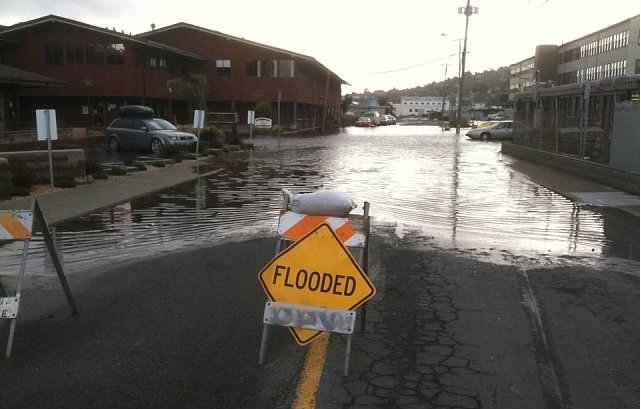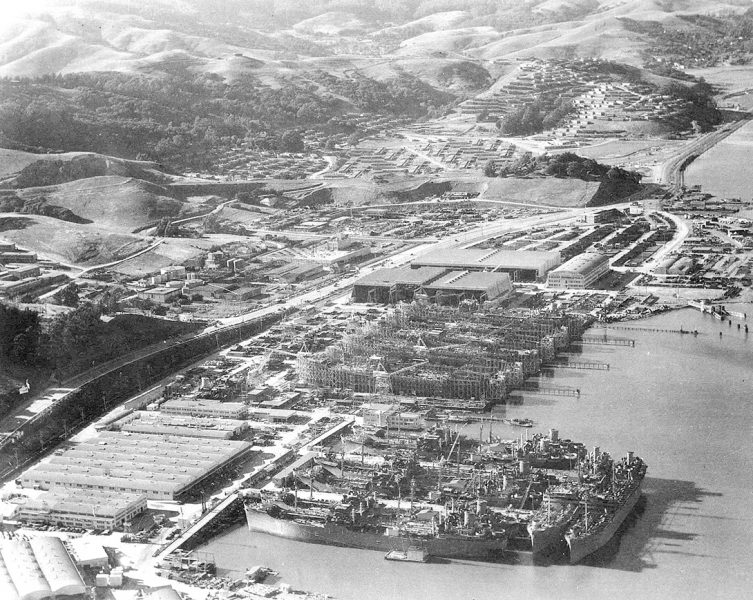
Sausalito City Council Opens Door for Housing in the Marinship
In mid-February, the Sausalito City Council unanimously passed its General Plan update, which will serve as the city’s blueprint for growth for the next 20 years. Included in the General Plan, which was the result of a separate 3-2 vote by the city council, is “language on a citywide zoning overlay” that could potentially open the door to housing in the Marinship, Sausalito’s historic working waterfront.
As we’ve reported, the Marinship is an economic powerhouse — generating some 46% of Sausalito’s business property taxes — that sits on a sliver of land hastily developed during World War II and now plagued by toxic soil and flooding, among other problems.

“I don’t want to tell people this is a dandy place to raise your kids if it’s going to flood and it’s toxic and all of a sudden somebody decides to put affordable housing on there,” Sausalito mayor Jill Hoffman was quoted as saying by the Marin Independent Journal.
In a Marin Post article, Bob Silvestri said that the new General Plan does not specifically address toxins, sea-level rise, etc., but does suggest that more studies should investigate these issues. “In fact, the city already has numerous studies, going back over 30 years, all of which come to the same conclusion: Remediation and repair needs to be done now and on an area-wide basis, because the environmental hazard impacts are far too comprehensive and expensive to be addressed on a project-by- project basis,” Silvestri wrote.
“But again, all this fell on deaf ears,” he added.
Former Sausalito mayor and current city councilperson Susan Cleveland-Knowles — who was among the three councilmembers who voted for the “housing overlay” — cited “a growing senior population and discriminatory housing restrictions against Black families after World War II, which has led to a ‘shocking lack of diversity’ as reasons to open up the possibility of housing citywide,” according to the Journal. “I would love to turn the corner on that policy in Sausalito and start to open up more housing opportunities for our families of Marinship workers and other workers, including our maritime workers, our essential workers, to make this a more equitable community.”
(New city councilperson Ian Sobieski beat incumbent Joan Cox — who was against new land-based housing in the Marinship — by a single vote back in November 2020. Sobieski was also among the three voting for the housing overlay. We think it’s more than fair to assume that if Cox were still on the city council, the overlay would have been struck down.)

Vice mayor Janelle Kellman, who was recently elected to Sausalito’s city council, told the Journal that environmental justice and racial justice are intertwined, and that she is not comfortable putting underserved populations in the city’s most problematic area without further review. “We should not use racial justice as a reason to potentially put affordable housing in an area that is known to be contaminated and flooding and sinking when we know we have something coming up, the housing process, that will allow us to give this the due diligence it really requires,” Kellman said.
Silvestri echoed that concern. “Councilmember Cleveland-Knowles’ way of governing ensures that the negative consequences of existing environmental hazards in the Marinship will inevitably fall on the backs of the poorest and most disenfranchised among us. They are the ones who would suffer the most from the City’s decades-old refusal to address the Marinship’s existential, environmental hazards.”
Despite near-universal praise for Sausalito’s working waterfront, actually doing business in the Marinship remains a difficult proposition. Silvestri noted that “while the new General Plan is filled with verbiage about supporting the existing maritime/industrial/artisan community in the Marinship, today, dozens of essential maritime and industrial businesses are forced to operate under adhesive month to month leases, precluding them from daring to complain about hazards or grow their businesses in place or make much-needed, long-term investments in their facilities.”

The question of permitting housing in the Marinship zone is tough enough what with issues mentioned. However the biggest environmental hazard was omitted (again) by the council and the media.
The entire area was built on fill. Many structures are literally sinking and as they sink, they break the private sewer lateral pipe connecting the property to the sewer main. Because this occurs underground, it is possibly unnoticed. The effluent will occasionally flow into streets when the ground is saturated from rains or high tides. Sausalito has no routine inspection of the laterals until a property is sold, which rarely happens for commercial property. Meanwhile, the sewage leeches into the bay. And at high tides, seawater inflows into the main line side of the broken lateral and the salt water flows to the sewage treatment plant in the south part of sausalito, near Cavallo point, causing early corrosion and premature failure of the entire pipe system at the treatment plant. This has led to numerous breakdowns and spills into the bay.
The Marinship zone as it exists now and would be under the new general plan is an environmental disaster. Building housing there, regardless of motive adds to the problem.
This article is thoroughly biased and inaccurate. The Marinship is not a thin “sliver” of land, it consists of over 225 acres. It is NOT all landfill. Among other things, it includes the bedrock of the former Pine Point neighborhood that was demolished and dynamited to create most of the landfill that was used in other areas of the Marinship. There may be some toxic residue in this large area, but there are no specific known toxic hot spots and several parcels that have multiple clean soil tests showing no toxic materials. The City convened a forum on the future of the Marinship in September of 2019 which was attended by over 170 people. The outcome of that forum was overwhelming support for BOTH protecting the maritime industrial waterfront AND for creating new housing, especially along the Bridgeway Boulevard street front, which has no industrial activity, no known toxic issues and is not susceptible to flooding. Bob Silvestri does not live in Sausalito and is a professional housing opponent. I am an affordable housing advocate with no potential financial benefit from the creation of affordable or senior housing.
Ron — We disagree that any of the articles referenced in this article are inaccurate, but perhaps “sliver” isn’t the best term to describe the Marinship. (We were referring to the working waterfront’s overall size when compared with the totality of Sausalito, including the hills. But again, not the best choice of words.) We try to rise above simple labels such as calling someone “anti-housing,” because this language lacks the nuance that characterizes a fruitful debate over sustainable housing and development. (Why we certainly can’t speak for all of Bob Silvestri’s points of view, we don’t believe he’s a “professional housing opponent.” In fact, he’s an architect and real estate developer, as well as president of a nonprofit that advocates for economic, social and environmental sustainability, and for transparency in public processes.)
Regarding the forum on the Marinship, keep in mind that there were several unanimous (5-0 votes) by the Sausalito City Council, Planning Commission and General Plan Working Group, “all of whom decided that there should be no land-based housing east of Bridgeway, unless and until there is a thorough analysis during the upcoming Housing Element Update process,” according to Silvestri who added that Vice Mayor Janelle Kellman said that ignoring those previous votes would render these years of community engagement meaningless.
Let’s forget about housing for a moment, though. As a sailing magazine, we don’t claim to be experts in housing policy, though we again stand by our assertions. Yes, there is overwhelming support for Sausalito’s working waterfront, but what is anyone doing to actually protect and improve it? At present, maritime business must run on month-to-month leases, which prevents them from invest in infrastructure, and according to some sources, can drive down the overall value of the business.
Support and praise are meaningless without tangible action.
Keep up the great reporting Tim! And as your piece clearly show – no matter which side you stand on – Your Vote Matters!
Great post Tim, keep up the good work. Latitude needs more stories like this.